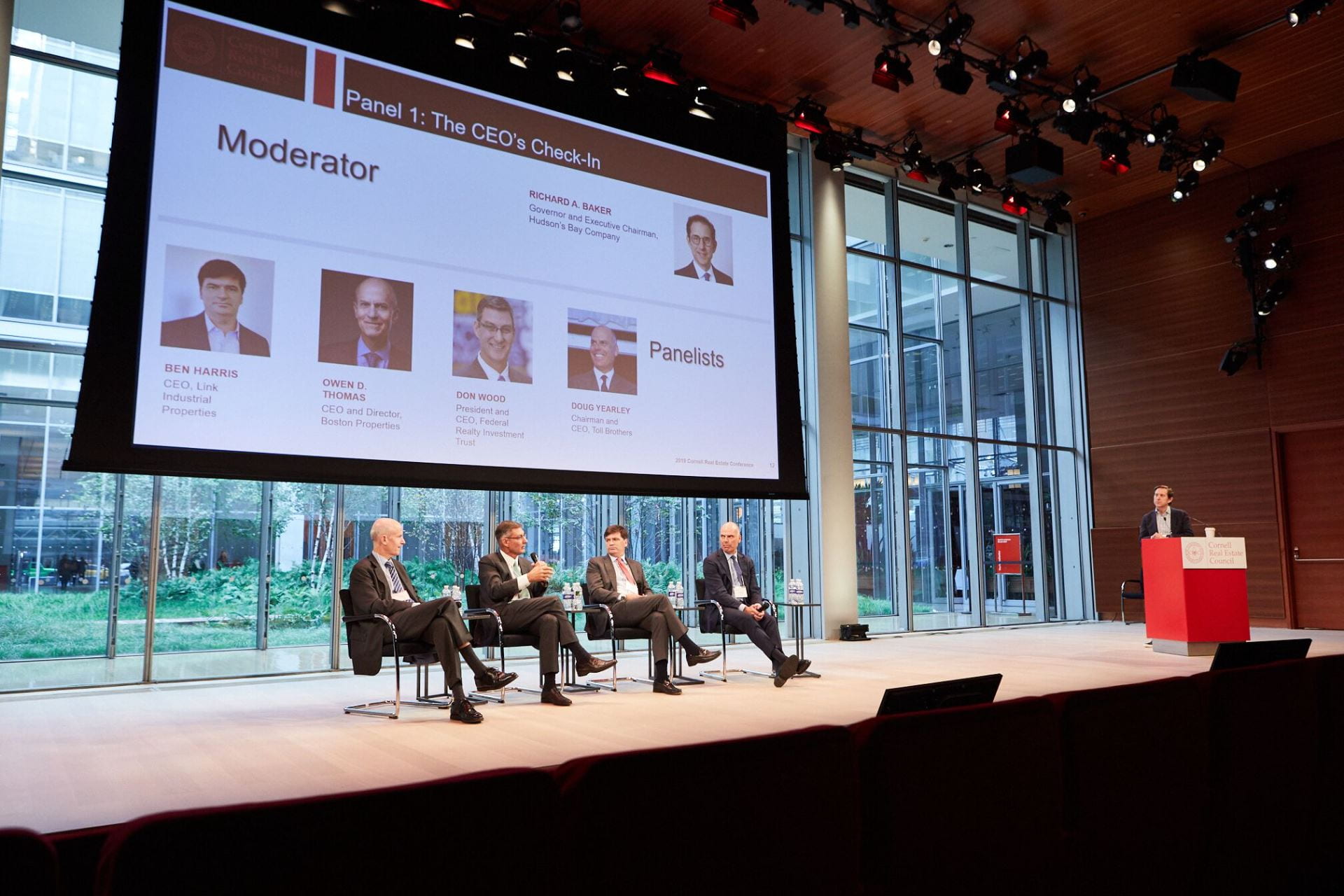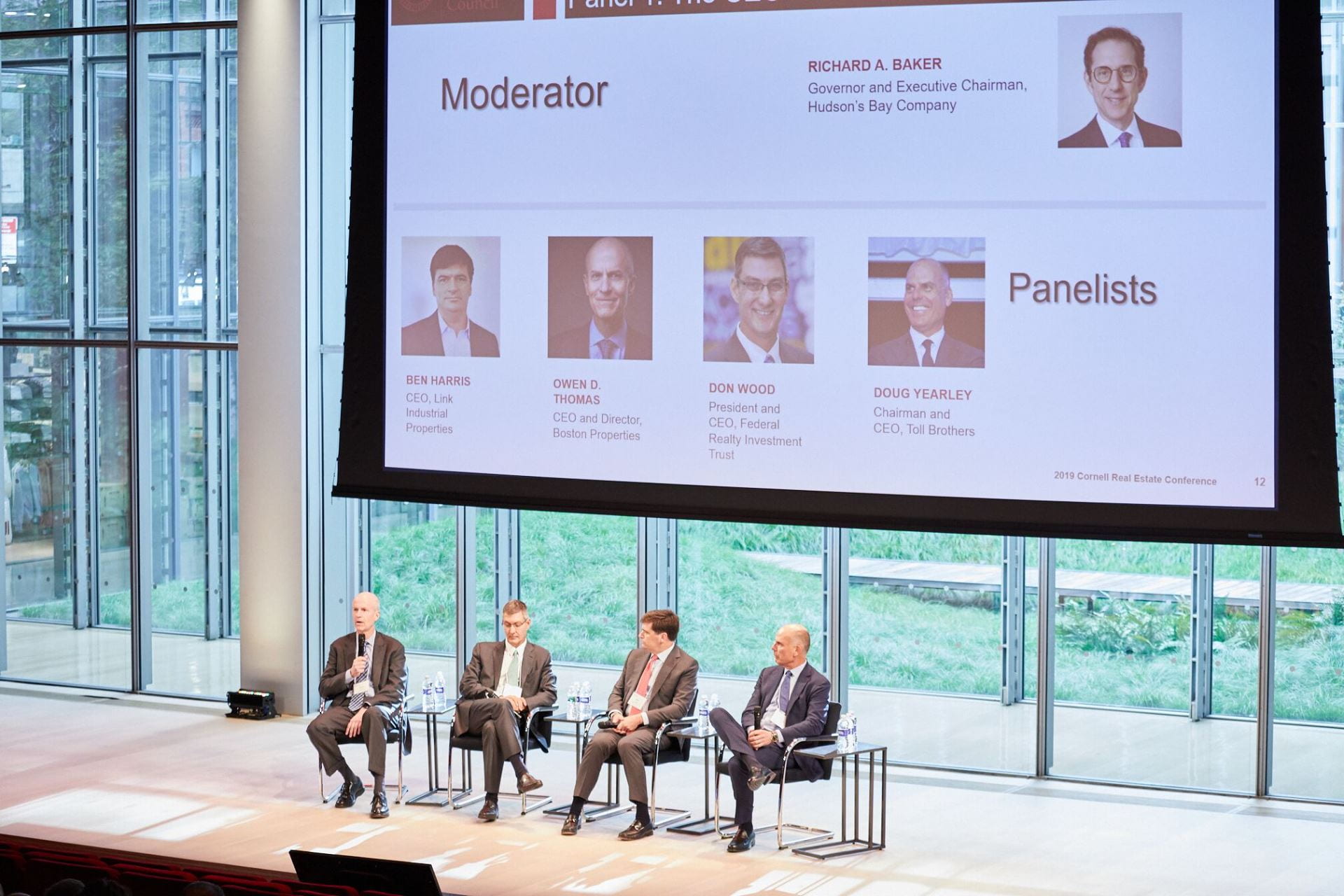
The theme of the 37th Annual Cornell Real Estate Conference was “20/20: Hindsight and Foresight” and featured panelists who discussed the unfolding challenges, disruptions, and opportunities in commercial real estate as 2020 approaches. Opening remarks by the Cornell Real Estate Council’s Chairman Paul Rubacha, Co-Founder and Principal of Ashley Capital, and Board Member Lynn Zuckerman Gray, Founder and CEO of Campus Scout, LLC, set the tone, after which Alan Riffkin, Managing Director at Lazard, introduced the first panel: “The CEO’s Check-In.” The panelists were Owen Thomas, CEO & Director of Boston Properties; Don Wood, President & CEO of Federal Realty Investment Trust; Ben Harris, CEO of Link Industrial Properties; and Doug Yearley, Chairman & CEO of Toll Brothers. The moderator for this panel was the benefactor and Advisory Board member of Cornell’s Baker Program in Real Estate, Richard Baker, Governor of Hudson’s Bay Company and an owner of National Realty & Development Corporation.
Baker initiated the dialogue by asking the panelists to identify the biggest trends that they are currently seeing within their particular asset class. As the CEO & Director of Boston Properties, a Class A office building owner, manager, and developer, Thomas first identified that the current leading net absorbers of office space include almost exclusively tech companies, life sciences companies, and co-working operators. This has shifted Boston Properties’ focus towards identifying office spaces where these companies want to locate. Thomas expanded on shared office space and co-working’s radical impact within the asset class and wrapped up his response by identifying the recent trend of capital flows into the office industry from private, not public, companies.
Wood, as President & CEO of Federal Realty Investment Trust, began with the observation that retail in this country is over-supplied. It is either over-developed or under-demolished, however one chooses to view it. Wood believes that the over-supply has provided a unique opportunity in the stronger U.S. markets. He identified these markets as locations where the currently booming industries are located. Northern California with its tech industry and Boston with its medical tech industry are two of Federal Realty Investment Trust’s current favorite markets, preferred over other areas in locations such as Philadelphia and Washington D.C.
While Wood did not initially speak about e-commerce’s effect on retail, Harris of Blackstone’s US industrial real estate platform, Link Properties, identified this as the number one trend within the industrial asset class. Harris’s focus is to truly understand how companies are moving products around the country and how that may change or adapt in the future. This means that while other asset classes may focus on rent differentials over location, he wants properties where location is the most important factor so that Link is well-positioned in the “Last Mile” delivery competition. Additionally, Harris cited how his industry has really set out on a path of its own, having disconnected its correlation to the overall economy around 10 years ago, mainly due to the massive growth in e-commerce.
Yearley, Chairman & CEO of Toll Brothers, provided perspective from the residential industry’s point of view. Demographic trends, whether that is the growth of active adult baby boomers or first-time home-buying millennials, affects what the company is building and where it is building it. The “smile states,” from California to the Carolinas, are where Yearley sees most of the residential growth taking place over the next several years. Toll Brothers is striving to create homes and spaces in these states, citing connectivity as the number one desire for their home buyers.
Baker then steered the conversation towards innovation and asked each panelist to identify the biggest innovations their company is currently undertaking. In addition to placemaking and property technology, Thomas first noted the downtown evolution and its effect on office space as having transformed Boston Properties’ development locations. Boston Properties has seen premiums in selling or renting office space in buildings they have elected to “freshen up.” Some of these decisions have been influenced by the growth of PropTech and its ability to identify densities, traffic counts, what is going on inside the building in real time. Wood wholeheartedly agreed that placemaking could exponentially impact the attractiveness of a retail center as well, citing a 15-25% premium in desirable centers with high-level amenities. Although similar amenities may not matter as much in the industrial sector, design innovations are taking place. The movement towards multi-story warehouses is an effort to capture increasing demand and rents, as well as truck movement efficiency. These are the leading innovative trends that Link Industrial is seeing, according to Harris. Meanwhile, according to Yearley, Toll Brothers’ design innovations are influenced by consumers’ desires for modern, casual, open floor plans that compliment their connected locations, which is a completely different home model than what was desired 15 or 20 years ago.
Following Yearley’s comments, Baker turned the discussion to a new term that seems to have attracted attention within the industry: “Hipsturbia.” With everyone talking about the evolution, revitalization, and movement back into America’s downtowns, are we on the verge of a movement back to the suburbs at some point in the future? All four panelists agreed that suburbs are not dead, the “American Dream” is still alive and well, and suburbs are actually thriving in cities like Nashville, Dallas, and Phoenix. While connectivity is still key, Yearley remarked that many people are still leaving cities when their kids hit kindergarten – as they want the big house, the big yard, the good school, the prime zip code – all of which are found in the suburbs. To support this fact, Yearley cited data which confirms that premiums for new homes are higher than they have ever been versus existing homes, meaning that companies like Toll Brothers are still building, and consumers are still buying, in the suburbs at a high rate.
Baker concluded the panel with a synopsis of the discussion, identifying his key takeaways. The concentrated location of new jobs and new job growth, the demographic movements, and placemaking maintained a constant theme in the hour-long conversation amongst the CEOs. What was most evident to Baker, and likely members of the audience as well, was the fact that commercial real estate continues to be a fantastic, creative, and thriving industry in which to work.



